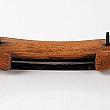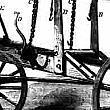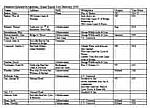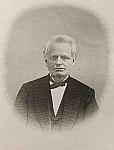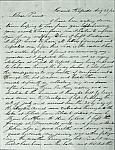Charles C. Comstock, the Early Days of Grand Rapids
by Charles C. Comstock
.jpg) In 1847 I visited the West as far as Chicago, Detroit then containing as claimed 14,000 inhabitants, Milwaukee the same and Chicago 13,000. The latter was the most uninviting of either, apparently little better than a swamp. Detroit and Milwaukee were different, on high and dry lands, and very pleasant for residence or business houses.
In 1847 I visited the West as far as Chicago, Detroit then containing as claimed 14,000 inhabitants, Milwaukee the same and Chicago 13,000. The latter was the most uninviting of either, apparently little better than a swamp. Detroit and Milwaukee were different, on high and dry lands, and very pleasant for residence or business houses.
I went by the Lakes on a nice little steamer, the English boat “London”, from Buffalo to Detroit and a large American Steamer, “The Great Western: from Detroit to Milwaukee, and another steamer from there to Chicago. I returned from Chicago to St. Joseph, Michigan by the small steamer “Champion.” It was very rough and cool on the Lake; we were all sick.
From St. Joe to Hillsdale I travelled by stage and I like most of the country, especially Sturgis. From Hillsdale to Monroe there was a railroad owned by the State of Michigan. The track was built entirely of wood except a strap rail, like coit tyre, perhaps 4 inches wide and the spikes to hold it to the wood, and it was dangerous to run faster than six or eight miles an hour. The same year that railroad was sold to an Eastern company and is now part of the Michigan Southern RR. Another railroad from Detroit to Kalamazoo was built by the state and sold to what has since been the Michigan Central RR.
There were large improvements in the southern part of the state, but probably at least 98 per cent of the whole was original forest.
SETTLING IN GRAND RAPIDS
After we settled at Grand Rapids, in 1853, I spent a week or two looking about the city doing nothing and never felt that I was of so little account before in my life.
The first work I performed in Michigan was in charge of a gang of men upon the Grand Rapids and Kalamazoo Plank Road, in Allegan County, north of Wayland. I was in the employ of the directors of the road, Dr. Shepard and W.H. Withey. While there I learned that there were some government lands in the township of Dorr; Dr. Shepard and I drove out. Shepard paid $400 for a section near the Plank Road, and sold it to J. W. Squires in three months for $1000.
The government pinelands were mostly taken south of Kalamazoo, but I purchased a 1/3 interest in 1200 acres in company with Surrell Wood and Deacon Losing Chapin, in the town of Ashland, Newaygo County. The next season I purchased 920 acres of the government on White River.
I commenced to put in a small stock of logs on Rouge River, in company with Deacon Chapin, who was a very honest and true man in all his dealings. The price then for logs was about $2.00 per M. ft. at the river, but we only secured about 900M ft. that winter. At the end of the first year my investments in land and sales, with some $3000 made in the lumber business, I was as I considered worth $30,000, $20,000 made in one year.
Comstock was not a newcomer to the timber business. In his native New Hampshire in the winter of 1841-42 he described his experience. “I had a little hemlock timber which I wished to cut. A family who owned a saw mill only a quarter of a mile from the timber were rather indolent, good cider drinkers, and very independent. I had been in the habit of hauling logs to their mill and it was about impossible to get them sawed. I got vexed and tried to hire their mill. They would not rent it. I then made an effort to sell them my timber for less than it was worth. They would not buy. I told them if they would neither lease me their mill nor buy my timber I would build a mill myself. The same stream on which their mill stood ran through my farm about 60 rods above theirs. I went to work and put up a very good saw and shingle mill for that country, which cost me $1000. I used up much of my timber in building the mill and the dam. I ran the mill ten years and left very little timber there."
WINCHESTER BROTHERS
Enoch W. Winchester (brother to Comstock’s wife, Mary Winchester) moved from New Hampshire to Grand Rapids in 1854, and went in company with Deacon Haldane in the furniture business, manufacturing and retailing. They had a small shop in the rear and warerooms on Canal St. where the north 25 ft. of the Pantlind now stands. I had made something in the lumber trade and Enoch was desirous to get an interest in that business. Samuel Winchester was expected to move to Grand Rapids in 1855, and he would want to engage in something.
When Samuel came in April he did not wish to take the interest I had secured for him, but went into the grocery business. In the fall of that year he became somewhat embarrassed or needed more capital so I put in $2000, an equal amount of his investment. The enterprise was a failure, so far as to profits, but the debts were all fully paid, and I drew of the division of the assets goods worth much less than the money I put into the business. After this Samuel went into company with Enoch and built a furniture factory on Lyon St., and their sales rooms on Canal St.
FINANCIAL COLLAPSE 1857
In the fall of 1857 Enoch and Samuel became embarrassed. I had endorsed some of their paper, which they were unable to pay and they had got about to the end of the rope. On Sept. 15th with the advice of Judge Withey, their own and my attorney, I bought out their property and business, with the expectation that Enoch would remain with me in charge of the factory. Fifteen days after this purchase, Oct. 1st,came the noted crash of 1857. Money all left the country. After purchasing of the Winchesters’ I immediately finished up their furniture factory so as to make it comfortable for winter. I was preparing to deliver $500 worth of goods per day, the product of my own factory. For many months after Oct. 1, 1857 I was unable to get one per cent of that amount in cash. My credit was
first rate but I could see it was only a question of time as regarded my ability to keep running. I kept the works all running except the sash and door works. During the three or four years that followed, property, especially unimproved real estate was not of any value. Much was sold for taxes and never redeemed by former owners. I was determined to pay 100 cents for every dollar I owed. I had a good faculty to dicker and sold my goods during the years of 1858-59-60 for anything and everything my men needed, and which they were pleased to receive in exchange for their labor. In the whole year of 1859 I was only able to sell or exchange $6900 worth of furniture. In the fall of 1863 was selling upon the same floor $12,000 per month and nearly all for cash.
But the dark days from Oct. 1, 1857 to early in 1862 were beyond any description I can give. I arose a daybreak, my wife would fry a few griddlecakes for my breakfast. I would east alone and start for the factory, came home for my dinner and seldom left my office before ten in the evening. In 1861 money was almost impossible to get, and worth 3 per cent per month at the banks, and often the moneylenders took twice that for interest. One case, James Belknap while clerking for me lent one hundred dollars to W.H. Stewart and made Stewart pay him $8 per month for its use.
Things did look very dark indeed, but in the fall of 1861 though severely embarrassed I nearly doubled my factory and machinery, for I had concluded that I must have both in order to make any money in the furniture trade, and that I must sell more than I could sell and Grand Rapids.
When I began to do this Daniel Ball, who was friendly to me, asked me if the condition of business in the country was such as to enlarge my works. I told him it was a good time to build for everything was remarkable cheap and I proposed to take advantage of it. In the spring of 1862 business improved and I had my factory in condition to manufacture about double it had ever been able to do before.
Excerpted from, Early Experiences and Personal Recollections of Charles Carter Comstock, written in Washington D.C. Begun January 4, 1887. Copied in 1936 by Etta Comstock Boltwood. Grand Rapids Public Library, Coll. #008
Return to Photo Essay

 facebook
facebook